
HOME ARTICLES ABOUT LINKS CONTACT
We
do not collect, store, or sell personally identifiable information.
Third party advertiser pixels may be present.
Continued
navigation of the site will assume consent. Accept Privacy
Policy Opt-Out
DESTINATION
IDEAS
California
Nevada
Other
West
Bargain Travel West guide to unique destinations, sight-seeing, budget travel
vacation ideas for the independent traveler in the U.S., Canada and Caribbean.
Los
Angeles Tour and Attraction Discount Tickets
Travel Bargain destination
in Los Angeles
LA BREA TAR PITS & PAGE MUSEUM
Ice Age Fossils in Los Angeles
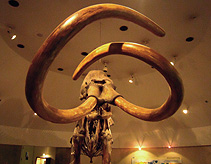 The
La Brea Tar Pits have been one of the most famous features of Los Angeles
ever since the city grew from the coastal plain where the waters
of the Pacific Ocean receded 100,000 years ago. In early years, photographs
of the Hancock Park area west of downtown can be seen crowded with a
forest of oil wells, drilling for the oil formed from the biomass of
the ocean floor covered with earth over the eons. The oil wells were
replaced by houses and business buildings along the Wilshire corridor.
But on the spot where nothing could be built were the pits and pools
of tar seeping to the surface for the past 40,000 years. The pits of
black
oily
goo covered with a shallow layer of water would attract animals of the
Ice Age to get caught in the sticky tar, especially in the warm summers.
The larger animals trapped would be attacked as easy prey by other predators.
They would also get caught and ultimately buried in deep asphalt deposit
layers.
The
La Brea Tar Pits have been one of the most famous features of Los Angeles
ever since the city grew from the coastal plain where the waters
of the Pacific Ocean receded 100,000 years ago. In early years, photographs
of the Hancock Park area west of downtown can be seen crowded with a
forest of oil wells, drilling for the oil formed from the biomass of
the ocean floor covered with earth over the eons. The oil wells were
replaced by houses and business buildings along the Wilshire corridor.
But on the spot where nothing could be built were the pits and pools
of tar seeping to the surface for the past 40,000 years. The pits of
black
oily
goo covered with a shallow layer of water would attract animals of the
Ice Age to get caught in the sticky tar, especially in the warm summers.
The larger animals trapped would be attacked as easy prey by other predators.
They would also get caught and ultimately buried in deep asphalt deposit
layers.
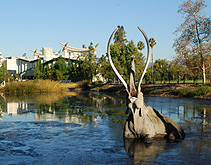 The
La Brea Tar Pits were named a National Natural Historic site in 1962.
The most visable feature of the La Brea Tar Pits is the small lake
next to the Los Angeles County Art Museum which remains active. Replica
statues of a family of California Mastadons have been placed to give
a representation of what it would be like for an animal to be trapped
there. Bubbles of gas occasionally boil up from below, reminding that
the forces which formed the pits are still active. Though subtle and
not unpleasant in a curious sort of war, the air smells of the acrid
asphalt aroma as if roofers were at work nearby. The animal statues are
fake, but the lake tar pit is very real, now surrounded by a fence.
The
La Brea Tar Pits were named a National Natural Historic site in 1962.
The most visable feature of the La Brea Tar Pits is the small lake
next to the Los Angeles County Art Museum which remains active. Replica
statues of a family of California Mastadons have been placed to give
a representation of what it would be like for an animal to be trapped
there. Bubbles of gas occasionally boil up from below, reminding that
the forces which formed the pits are still active. Though subtle and
not unpleasant in a curious sort of war, the air smells of the acrid
asphalt aroma as if roofers were at work nearby. The animal statues are
fake, but the lake tar pit is very real, now surrounded by a fence.
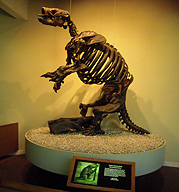 The La Brea Tar Pits get their name from a Mexican Land Grand called
the Rancho La Brea (Brea is Spanish for tar). There is a main avenue
in Los Angeles called La Brea running from Hollywood south, but the
tar pits are not on that street. They're about a mile west on Wilshire
Boulevard. The George C. Page Museum in the park surrounding the pits
was opened in 1977 to house the finds from the excavations and tell
the history story of the pits and the animals found there. The Page
Museum, dug into a mound underground now holds the world’s richest
and most important collection of Ice Age fossils. Because the surface
pools would catch both preditor and prey as well as leaves and insect
which would get caught in tar, the entire story of a place in time
is told by the fossil record. There are no dinosaurs at the La Brea
Tar Pits. They were long extinct by the time the ocean receded from
the California coast. The bones found at the tar pits are all from
the age of prehistoric mammals - like those creatures from the Ice
Age cartoon movies, characters partially inspired by visits to the
Page Museum.
The La Brea Tar Pits get their name from a Mexican Land Grand called
the Rancho La Brea (Brea is Spanish for tar). There is a main avenue
in Los Angeles called La Brea running from Hollywood south, but the
tar pits are not on that street. They're about a mile west on Wilshire
Boulevard. The George C. Page Museum in the park surrounding the pits
was opened in 1977 to house the finds from the excavations and tell
the history story of the pits and the animals found there. The Page
Museum, dug into a mound underground now holds the world’s richest
and most important collection of Ice Age fossils. Because the surface
pools would catch both preditor and prey as well as leaves and insect
which would get caught in tar, the entire story of a place in time
is told by the fossil record. There are no dinosaurs at the La Brea
Tar Pits. They were long extinct by the time the ocean receded from
the California coast. The bones found at the tar pits are all from
the age of prehistoric mammals - like those creatures from the Ice
Age cartoon movies, characters partially inspired by visits to the
Page Museum.
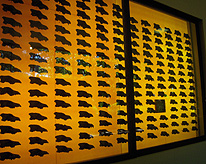 Full
skeletons on display in the Page Museum include American Mastadons,
a Saber-toothed Tiger, prehistoric Short-faced Bear, Dire Wolves, and
giant Ground Sloth. A principal and unmistakable feature of the museum
is the wall of wolf skulls. Why were so many found in the pits? Once
a large animal like the massive Columbian Mammoth skeleton with its incredible
curved tusks would get stuck in the tar, the plentiful wolves would come
from miles around, leaping to attack, their last easy meal. Displays
at the museum also show life-like figures of the skeletons as they would
have been, like a pack snarling Dire Wolves on the prowl. If you want
to see dinosaurs, you have to go down to Exposition park for the new
Dinosaur Hall (see Dinosaurs
at LA County Museum).
Full
skeletons on display in the Page Museum include American Mastadons,
a Saber-toothed Tiger, prehistoric Short-faced Bear, Dire Wolves, and
giant Ground Sloth. A principal and unmistakable feature of the museum
is the wall of wolf skulls. Why were so many found in the pits? Once
a large animal like the massive Columbian Mammoth skeleton with its incredible
curved tusks would get stuck in the tar, the plentiful wolves would come
from miles around, leaping to attack, their last easy meal. Displays
at the museum also show life-like figures of the skeletons as they would
have been, like a pack snarling Dire Wolves on the prowl. If you want
to see dinosaurs, you have to go down to Exposition park for the new
Dinosaur Hall (see Dinosaurs
at LA County Museum).
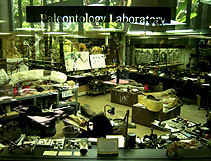 Excavations and recovery
are still ongoing at the tar pits. The excavation sits can be viewed
along trails in the park. The main Pit 91 was the
most recent excavation site. There is a viewing window on the excavation,
a pit of black hardened tar with steel supports, but work there has been
suspended in favor of Project 23. Construction of a new underground parking
structure for the LACMA art museum behind the former May Company building
revealed more tar. As construction crews come to deposits, they cut out
chunks of the stuff and pack it in large crates. The crates of tar sit
inside a fence called the Project 23 compound, waiting for researchers
to painstakingly work through the chunks. Once fragments or bones are
removed they are sent to the “Fishbowl” laboratory in the
museum, where museum visitors can watch through windows as the scientists
and volunteers clean, restore and catalog the fossils.
Excavations and recovery
are still ongoing at the tar pits. The excavation sits can be viewed
along trails in the park. The main Pit 91 was the
most recent excavation site. There is a viewing window on the excavation,
a pit of black hardened tar with steel supports, but work there has been
suspended in favor of Project 23. Construction of a new underground parking
structure for the LACMA art museum behind the former May Company building
revealed more tar. As construction crews come to deposits, they cut out
chunks of the stuff and pack it in large crates. The crates of tar sit
inside a fence called the Project 23 compound, waiting for researchers
to painstakingly work through the chunks. Once fragments or bones are
removed they are sent to the “Fishbowl” laboratory in the
museum, where museum visitors can watch through windows as the scientists
and volunteers clean, restore and catalog the fossils.
Visiting the Tar Pits & Page Museum
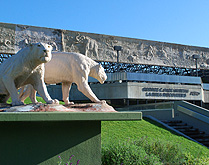 The George
C. Page Museum is open from 9:30 to 5pm every day except for 4th of
July, Thanksgiving, Christmas, and New Year's days. Admission
is $7 for adults, $4.50 for Seniors and Students and $2 for children
5 to 12. With admission, free tours are given both inside the museum
and of the outdoors park. Admission is free on the first Tuesday of every
month. A continuously running film tells the story of the tar pits and
the history of the area. The Museum Store offers an array of logo t-shirts,
Ice Age themed apparel, books, stuffed animals, toys and unique gifts.
If you want a deeper learning experience and encounter with paleontology,
the Page Museum has a volunteer program. The museum has a parking lot
for $7 for the day. There is street parking around, both metered and
some not on 6th Street to the east but read the signs very carefully.
The La Brea Tar Pits and Page Museum are next door the LACMA Art Museum
and the Petersen Car Museum is across the street at the corner of Wilshire
Boulevard and Fairfax Avenue. The outdoor park is free to enter - just
don't get stuck. © Bargain
Travel West
The George
C. Page Museum is open from 9:30 to 5pm every day except for 4th of
July, Thanksgiving, Christmas, and New Year's days. Admission
is $7 for adults, $4.50 for Seniors and Students and $2 for children
5 to 12. With admission, free tours are given both inside the museum
and of the outdoors park. Admission is free on the first Tuesday of every
month. A continuously running film tells the story of the tar pits and
the history of the area. The Museum Store offers an array of logo t-shirts,
Ice Age themed apparel, books, stuffed animals, toys and unique gifts.
If you want a deeper learning experience and encounter with paleontology,
the Page Museum has a volunteer program. The museum has a parking lot
for $7 for the day. There is street parking around, both metered and
some not on 6th Street to the east but read the signs very carefully.
The La Brea Tar Pits and Page Museum are next door the LACMA Art Museum
and the Petersen Car Museum is across the street at the corner of Wilshire
Boulevard and Fairfax Avenue. The outdoor park is free to enter - just
don't get stuck. © Bargain
Travel West
Web Info
George C.Page Museum
These articles are copyrighted
and the sole property of Bargain Travel West and WLEV,
LLC. and may not be copied or reprinted without permission.
See these other articles on Bargain Travel West:
"MUMMIES
OF THE WORLD"
California
Science Center - Exposition Park
SANTA
MONICA PIER
Historic Amusements of the Pacific Park
UNIVERSAL
STUDIOS HOLLYWOOD - TOUR
Fire, Water and Dinosaur Breath
MOTION
PICTURE ACADEMY
Visiting Oscar in Beverly Hills
BURBANK
BOB HOPE AIRPORT
Fly into LA On-Time and Avoid the Hassle of LAX
Discover the west with budget travel ideas at Bargain Travel West ©2006-2019 Winged Lion Entertainment Ventures, LLC